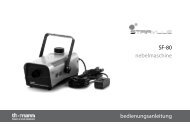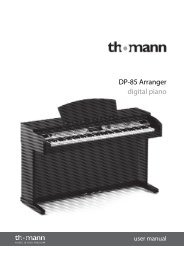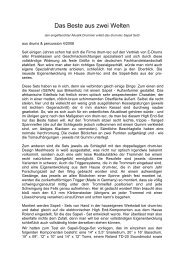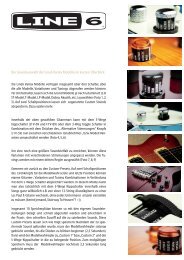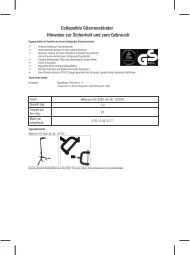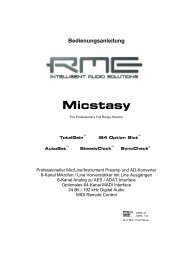You also want an ePaper? Increase the reach of your titles
YUMPU automatically turns print PDFs into web optimized ePapers that Google loves.
Direct mic channels (mono)<br />
Kick In<br />
Kick Out<br />
Snare Bottom<br />
Snare Top<br />
Snare Top<br />
Multi<br />
The signal from the mic inside the kick drum.<br />
The signal from the mic outside the kick drum.<br />
The signal from the mic underneath the snare drum.<br />
The signal from the first mic above the snare drum.<br />
The signal from the second mic above the snare drum.<br />
BFD ’s library is the first to contain this mic channel, which<br />
does not exist in previous BFD libraries.<br />
The signal from the direct mic for all Kit-Pieces except<br />
kicks and snares. This is usually empty for kicks and snares.<br />
Primary direct and bleed channels<br />
The kick and snare mics are used for all Kit-Pieces, as bleed signals are recorded through them.<br />
A Kit-Piece’s own close mic’d direct signal is known as the primary direct mic channel. For a kick, this is in the Kick In and Out mic<br />
channels, and for a hihat or cymbal, it is in the Multi mic channel.<br />
The Kick In/Out mic channels are the primary direct mic channels for the kick. Bleed from the kick appears in the Snare Bottom/Top<br />
mic channels. The Multi mic channel is empty for kicks, except on certain BFD XFL kicks, which feature bleed captured<br />
through the hihat mic.<br />
The Snare Bottom/Top mic channels are the primary direct mic channels for the snare. Bleed from the snare appears in the Kick<br />
In/Out mic channels. The Multi mic channel is empty for snares, except on certain BFD XFL snares, which feature bleed captured<br />
through the hihat mic.<br />
The Multi mic channel is the primary direct mic channel for all other Kit-Pieces, whose bleed appears in the Kick In/Out and Snare<br />
Bottom/Top mic channels.<br />
Bleed is only present in the kick and snare mic channels. Bleed from the other mics is not included, because the levels were too<br />
low and not useful enough to justify the extra RAM and hard disk bandwidth required. In any case, bleed can be, in many cases,<br />
an annoying side-effect of the drum-recording process, which is often minimized during post-processing by using noise gates.



